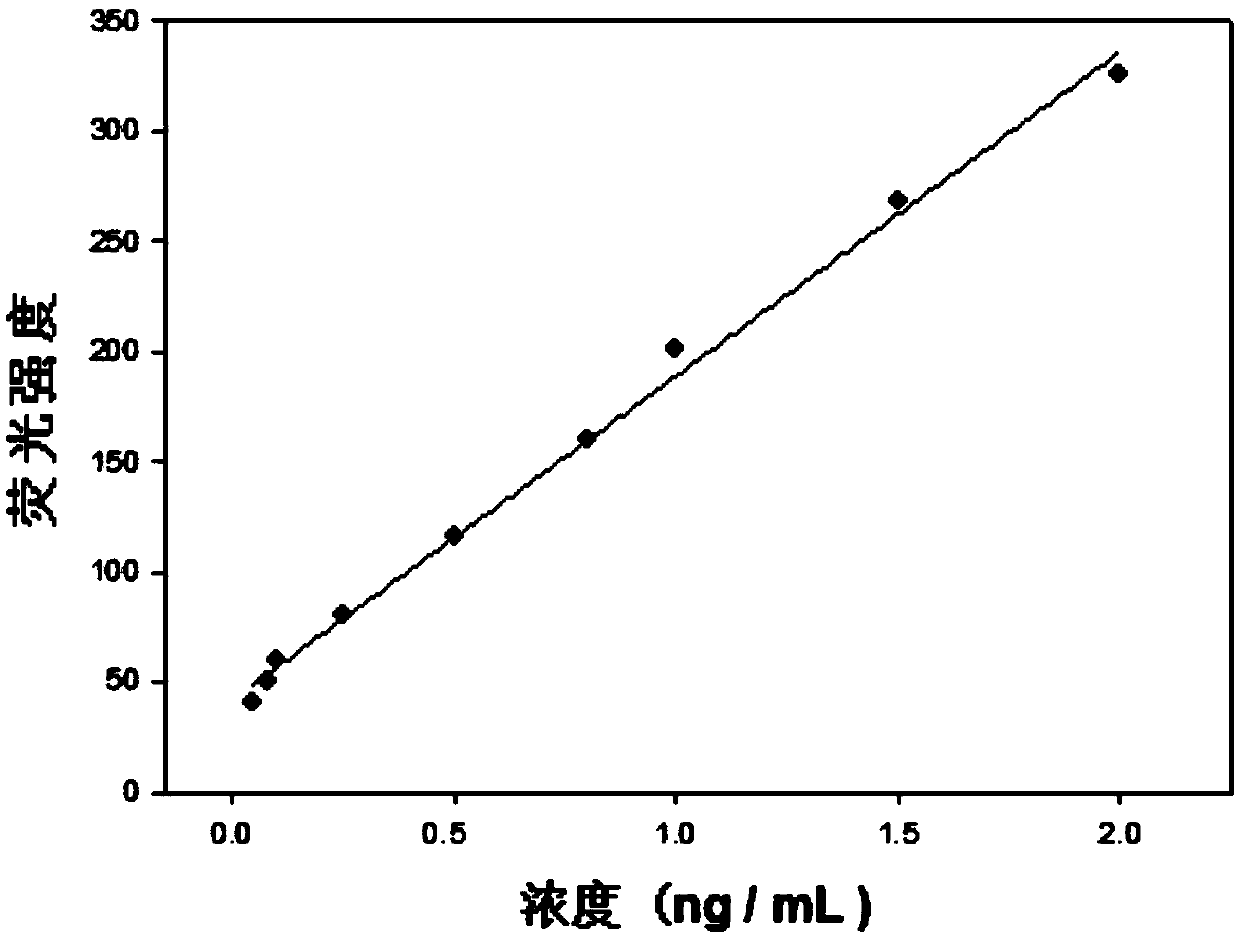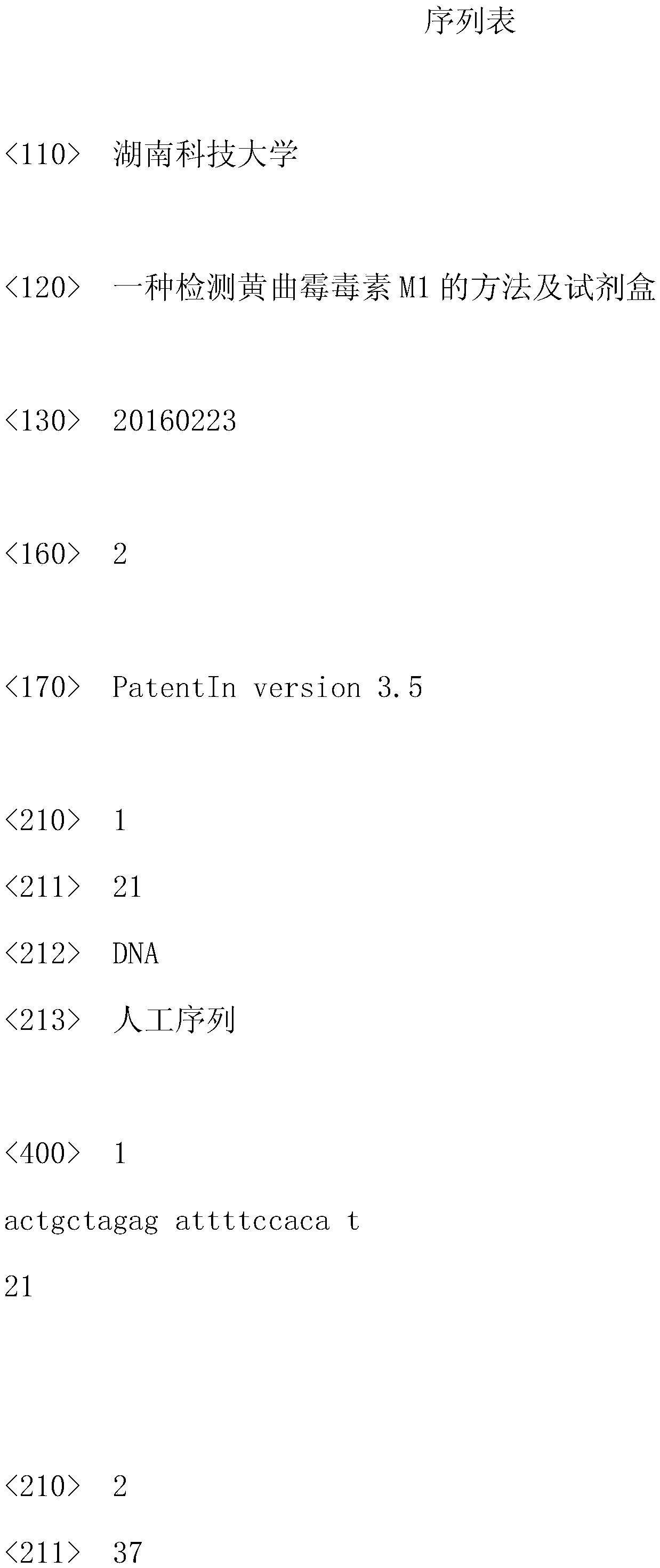Aflatoxin M1 detection method and kit
An aflatoxin and kit technology, applied in biochemical equipment and methods, microbial determination/inspection, etc., can solve the problems of high price, high detection cost, easy inactivation of biochemical reagents, etc., and improve detection sensitivity and accuracy. , the effect of eliminating interference
- Summary
- Abstract
- Description
- Claims
- Application Information
AI Technical Summary
Problems solved by technology
Method used
Image
Examples
Embodiment 1
[0022] The kit for detecting aflatoxin M1 in this embodiment includes: 40 μL of Tris buffer solution of 3.0 μmol aflatoxin M1 nucleic acid aptamer Apt, 40 μL of Tris buffer solution of 3.0 μmol single-stranded signal probe ssDNA, DNA amplification system, nucleic acid Exonuclease, silver ion reduction detection system. Aptamer Apt of aflatoxin M1 is 5'-ACTGCTAGAGATTTTCCACAT-3'. The single-stranded signal probe ssDNA is 5'-CCCCCCACACCCGATCCCCCCATGTGGAAAATCTCTA-3'. The DNA amplification system includes 10 μL amplification buffer solution, 18 μL deoxymononucleotide triphosphate mixed solution dNTP (10 mM), 2 μL Hi29 DNA polymerase (10 u / μl) and 10 μL NH 4 F (25mM)-NaCl (0.1M) solution; wherein, the composition of the amplification buffer solution is 50mM Tris-HCl, 10mM MgCl 2 , 10mM (NH 4 ) 2 SO 4 , pH7.5 (commercially available). The exonuclease was 2μL ExoIII exonuclease (20u / μL). The silver ion reduction detection system included 150 μL sodium citrate solution (10 mM, p...
Embodiment 2
[0024] The method for the detection of aflatoxin of the present embodiment, the specific operation process is as follows:
[0025]The Tris-HCl (50mM Tris-HCl, pH7.5) solution containing the aflatoxin M1 nucleic acid aptamer Apt and the Tris-HCl (50mM Tris-HCl, pH7.5) solution containing the single-stranded signal probe ssDNA were respectively incubated at 90°C After heating in a water bath for 5 minutes, it was quickly placed in an ice bath for 5 minutes. Take 40 μL of 3.0 μmol aflatoxin M1 nucleic acid aptamer Apt solution and 3.0 μmol signal probe ssDNA solution 40 μL respectively in a 2ml centrifuge tube after the above treatment, and hybridize at 37°C for 1 hour; ~50ng / mL of AFM1 was added to the above solution, and after 2 minutes, 10 μL of amplification buffer solution was added (the composition of amplification buffer solution was 50mM Tris-HCl, 10mM MgCl 2 , 10mM (NH 4 ) 2 SO 4 , pH7.5), 18 μL dNTP (10 mM) and 2 μLPhi29 DNA polymerase (10u / μl), reacted at 37 ° C fo...
PUM
| Property | Measurement | Unit |
|---|---|---|
| recovery rate | aaaaa | aaaaa |
Abstract
Description
Claims
Application Information
 Login to View More
Login to View More - R&D
- Intellectual Property
- Life Sciences
- Materials
- Tech Scout
- Unparalleled Data Quality
- Higher Quality Content
- 60% Fewer Hallucinations
Browse by: Latest US Patents, China's latest patents, Technical Efficacy Thesaurus, Application Domain, Technology Topic, Popular Technical Reports.
© 2025 PatSnap. All rights reserved.Legal|Privacy policy|Modern Slavery Act Transparency Statement|Sitemap|About US| Contact US: help@patsnap.com



